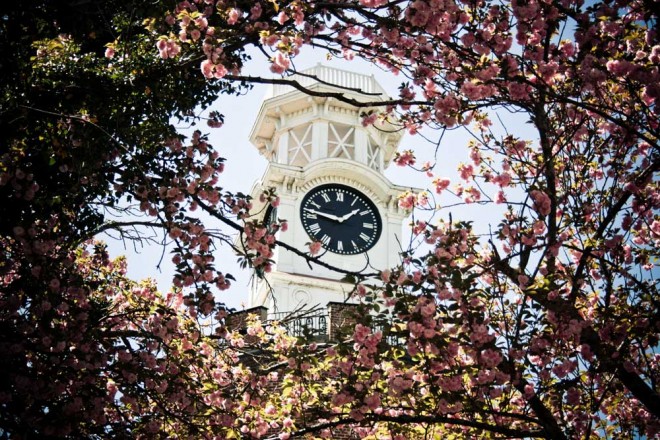MENU 800.444.1834
Visitor Guide
City Clocktower
East Second Street, Rome, GA 30161
Free
Clocktower History
The story of the Rome, Ga. Clocktower begins with Mr. James Noble, Sr. of Cornwall, England, who had moved his family of six sons and several daughters, from Reading, Pennsylvania to Georgia’s Rome. He purchased property along the banks of the Etowah River in downtown Rome and built an immense foundry and machine works. Here, he and his sons manufactured steam engines and other articles of iron and steel. When the South seceded from the Union, the Noble Foundry converted a large share of its production to cannon for the Confederacy. This activity became known to Federal forces which led to the occupation of Rome in 1864. Months later, General Sherman ordered the evacuation of Federal troops, the Noble Foundry destroyed, and most of the downtown area destroyed by fire.
Following this destruction and in an attempt to rebuild, Rome found itself badly in need of a waterworks. In 1870, the Noble family led a movement to upgrade the city’s water supply with the proposed construction of a water tower. This project was to have a cost of $100,000 – the city’s total revenue at the time totaled $21,000! The proposal became quite a political issue. The water tower was planned for the hill where the Clocktower now stands. There were those who insisted such terrific water pressure from opened faucets, would “knock the bottom out of a tin cup.” Needless to say, the issue passed, and in 1871 the water tower was built. The water tower is built of 10 foot sheets of iron, manufactured at the Noble Foundry. Transported to Neely Hill, these sections were hand – riveted together to form the tank. The tank itself is 26 feet in diameter and 63 feet deep and had a capacity of 250,000 gallons. It is surrounded by a red brick tower decagon in shape, with a three foot space to permit an interior spiral staircase of 107 steps. The tower is surmounted by a 41 foot superstructure containing the clock works and the four faces making it 104 feet high.
The clock was made by the E. Howard Clock Company of Boston, Massachusetts and was shipped to Rome on October 7, 1872, on the order of John W. Noble. Its face is nine feet in diameter, the minute hand is four feet and three inches and the hour hand, three feet and six inches. It is known by the manufacturer as their No. 2, hour – striking, eight day clock. The bell was made by the Meneely Bell Foundry of West Troy, New York. It is of genuine bronze, 32 inches high, and measuring 40 inches in diameter at its rim, which is 3 1/2 inches thick. Molded into its rim is the date “1872”. The bell has functioned properly since its original installation, but the first mechanism, an old hand windlass, has been replaced by a small electric motor.
Through the years several restoration projects have taken place. In 1986, the Rome Jaycees raised more than $80,000 to repair the brick structure and provide landscaping on the grounds around the tower. The most recent project, the creation of a museum within the Rome, Ga. Clocktower, became a reality in 1995, again through the fund-raising efforts of the Rome Jaycees.
Climb the Clocktower
Public tours are offered seasonally; group tours are available by appointment. Get tour details.
Climb the 107 steps to the top of the Clocktower for a great views of downtown Rome. A museum inside includes murals from Rome’s history and restored original clockworks.

